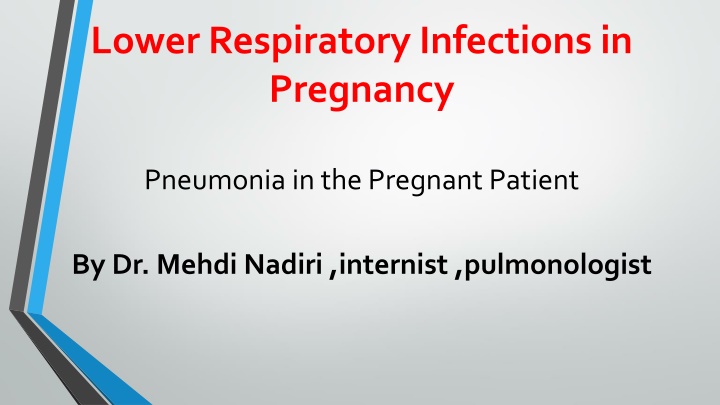Loops in Programming and Their Importance
Loops in programming allow for the repetition of actions in a controlled manner, making tasks like computing averages, iterating through lists, and reading files more efficient. Learn how loops work, types of loops like while loop, loop control variables, and the significance of break and continue statements in handling loop executions.
Download Presentation

Please find below an Image/Link to download the presentation.
The content on the website is provided AS IS for your information and personal use only. It may not be sold, licensed, or shared on other websites without obtaining consent from the author.If you encounter any issues during the download, it is possible that the publisher has removed the file from their server.
You are allowed to download the files provided on this website for personal or commercial use, subject to the condition that they are used lawfully. All files are the property of their respective owners.
The content on the website is provided AS IS for your information and personal use only. It may not be sold, licensed, or shared on other websites without obtaining consent from the author.
E N D
Presentation Transcript
Lower Respiratory Infections in Pregnancy Pneumonia in the Pregnant Patient By Dr. Mehdi Nadiri ,internist ,pulmonologist
Community acquired pneumonia is a common illness, and pneumonia and influenza serve as the seventh leading cause of death in the United States. In the pregnant patient, pneumonia is the most common cause of fatal non-obstetric infection
Risk Factors No significant difference in maternal age or parity between the women with pneumonia during pregnancy and those who do not Mean gestational age 24 -31 weeks a history of asthma anemia cigarette smoking and drug abuse the use of a tocolytic agent to delay labor as a risk factor for development of pneumonia antepartum corticosteroids
Pathogenesis of Pneumonia and its Complications in Pregnancy Pneumonia can complicate pregnancy, in part because of altered host defenses in the parturient woman, and pneumonia can lead to potential adverse consequences for both the mother and the fetus adding morbidity and mortality when compared to the non-pregnant host Particular types of pneumonia bear special significance for the pregnant woman, especially those of viral and fungal origin pneumonia in the pregnant patient leads to an increased likelihood of complicated preterm delivery compared to pregnancies in which infection is absent
Impact of Pregnancy on Pneumonia Risk Alterations in cellular immunity, especially in the second and third trimester, -protect the fetus from rejection by the Mother -decreased lymphocyte proliferative response -decreased natural killer cell activity - changes in T cell populations with a decrease in circulating helper T cells -reduced lymphocyte cytotoxic activity - and production of substances by the trophoblast that block maternal recognition of fetal major histocompatibility Antigens -hormonal changes during pregnancy -Elevation of progesterone, human chorionic gonadotropin, alpha fetoprotein, and cortisol may also inhibit cell mediated immune function -These changes can predispose to infection with certain pathogens such as viruses, fungi, and tuberculosis
Alterations in pregnancy predisposing to an increased incidence and mortality from pneumonia
some of the physiologic changes of pregnancy can make the pregnant woman more prone to a severe pneumonia course These include: elevation of the diaphragmby up to 4 cm decrease in functional residual capacity increase in oxygen consumption increase in lung water decrease the ability of the pregnant woman to clear respiratory secretions and aggravate airway obstruction associated with pulmonary infections pregnant woman are less able to tolerate even brief periods of hypoxia, particularly in the third trimester
Consequences of pneumonia on maternal and fetal outcomes The most common non-obstetric infectious cause of mortality Pneumonia in pregnancy carries an increased risk of adverse outcomes when compared to pneumonia in non-pregnant women While many series show low mortality rates overall from pneumonia in pregnancy viral lung infection and opportunistic lung infection still carry a substantial maternal mortality and morbidity Significant fetal complications have been observed in all of the large studies of pneumonia in pregnancy The majority of poor fetal outcomes occurred in mothers with underlying comorbid illnesses such as chronic respiratory disease, or other maternal disease A number of studies have shown that women with pneumonia in pregnancy are more likely to deliver prematurely and have babies that are small for gestational age SGA
Most pregnant patients with pneumonia do well, it is important to identify patients with additional risk factors for poor perinatal outcome such as comorbid illness, smoking, and drug and alcohol abuse to intensify monitoring in an effort to avoid fetal complications.
While no congenital syndrome has been attributed to antepartum pneumonia, fever, tachypnea, and hypoxemia may be harmful to the developing fetus. Preterm labor as a complication of infection may be the result of the uterine response to certain mediators of infection and inflammation
It is quite possible that the cascade of mediators released by the active host inflammatory response to infection could exert distant effects on the uterus, leading to a high rate of labor during the course of pneumonia
Any infectious agent that causes lung infection in the non-pregnant patient has been observed to complicate the course of pregnancy The relative incidence of infection with any given agent is difficult to estimate without the use of comprehensive methodology to diagnose the etiologic pathogen for pneumonia The most pathogens are S pneumonia and H influenza
Bacteriology of Pneumonia in Pregnancy (in decreasing order of frequency)
Varicella Pneumonia The overall incidence of varicella in pregnancy has been reported as 1 5 per 10,000 births and both fetal and maternal complications present several management problems for clinicians. Varicella pneumonia usually complicates primary infection in 0.3 1.8% of all cases, but as many as 9% of primary cases during pregnancy can be complicated by pneumonia
Influenza A is a common infection in pregnant women during epidemics and carries a higher mortality than in the non-pregnant patient , with the maternal mortality rates being as high as 30 50%in the 1918 epidemic In the Asian flu epidemic of 1957 1958, 10% of all deaths occurred in pregnant women and almost 50% of women of childbearing age who died were pregnant This increased mortality was especially noted in the third trimester.
Aspiration Pneumonia The pregnant woman is physiologically predisposed to aspiration because of -elevation of the intragastric pressure due to the gravid uterus -a relaxed gastroesphageal sphincter due to the circulating progesterone -delayed gastric emptying that accompanies pregnancy. -sedation and analgesia during labor -increased abdominal pressure and vigorous abdominal palpation during examinations and extraction of the baby The incidence of this complication has declined over time, with an increased awareness of the problem and with efforts directed towards prevention.
Clinical Features and Management of Specific Respiratory Infections Overall, the clinical presentation of pneumonia during pregnancy has not been found to differ substantially from the findings in non- pregnant adults, and include fever, cough, pleuritic chest pain, rigors, chills, and dyspnea
There are many different methods used to define severity of illness in patients with CAP, but the Pneumonia Severity Index (PSI) is most widely used in the United States to help define the need for inpatient care and the need for ICU care The PSI uses an assessment of patient age, comorbidity, and laboratory and clinical data to define a patient s risk of death, with scores leading to categorization into one of five groups, each with increasing mortality risk.
The limitations of scoring systems such as the pneumonia severity index and the APACHE score in pregnancy include the fact that some of the physiologic changes occurring in pregnancy may alter the scoring system: Physiologic anemia with hematocrit as low as 30 are normally seen in pregnancy. The white cell count may be physiologically elevated in pregnancy as well and numbers as high as 14,000 15,000 may be seen A lower creatinine in pregnancy with a normal range being 0.5 0.7. Therefore, while a creatinine of 1.0 may be normal in the non-pregnant population, it is clearly an abnormal value in pregnancy and may contribute to inaccurate scoring
Certain presenting signs suggest the need for ICU admission in the CAP patient and these criteria should probably be liberalized for the pregnant patient, because of a reduced physiologic reserve to tolerate hypoxemia. If certain infections are present, such as varicella-zoster, the potential for rapid progression in pregnancy is high enough that expectant ICU observation may be justified.
Criteria for severe CAP, used in the new ATS/IDSA guidelines, but not specific to pregnant women, include: The presence of at least one major criterion 1-the need for mechanical ventilation 2-septic shock requiring vasopressors The presence of three minor criteria . 1-respiratory rate of at least 30 breaths /minute 2- PaO2/FiO2 ratio 250mmHg 3-multilobar infiltrates 4-confusion or disorientation 5-BUN 20 mg/dL 6- WBC < 4,000/mm3 7- platelet count < 100,000/ mm3 8-hypotension requiring aggressive fluid resuscitation 9-hypothermia. The guidelines also suggested that criteria such as hypoglycemia, hyponatremia, asplenia (as in sickle cell disease), and unexplained acidosis be considered in deciding the need for ICU admission
Diagnostic Testing According to the American Thoracic Society/Infectious Diseases Society of America (ATS/IDSA) guidelines for the management of adults with CAP, all patients with suspected CAP should have a chest radiograph All admitted patients should also have an assessment of gas exchange (oximetry or arterial blood gas), routine blood chemistry, and blood counts. Blood cultures are only recommended in patients with severe illness, especially if there has been no prior therapy with antibiotics. Two sets of blood cultures are recommended. Sputum culture and gram stain should be obtained if a drug-resistant pathogen, or an organism not covered by usual empiric antibiotic therapy is suspected. Routine serologic testing is not recommended for any population with CAP. For patients with severe CAP, Legionella urinary antigen and pneumococcal urinary antigen should be measured and aggressive efforts at establishing an etiologic diagnosis should be made, including consideration of bronchoscopy.
Therapy Based on the expected organisms in pregnant women with CAP, therapy should be directed at Streptococcus pneumoniae (including DRSP in patients with recent antibiotic therapy, underlying chronic heart or lung disease, and those with exposure to a child in daycare), H. influenzae (especially in cigarette smokers), and the atypical pathogens such as Chlamydophila pneumoniae, Mycoplasma pneumoniae, Pneumonia in the Pregnant Patient and Legionella pneumophila (the latter in the setting of severe CAP)
In choosing an antibiotic for bacterial pneumonia, the safety of the agent in pregnancy must be considered, along with its efficacy Pencillins, cephalosporins, and erythromycin are all safe and potentially effective antimicrobials for CAP Clindamycin is probably also safe, but there is limited clinical experience with this agent Aminoglycosides should be used only if there is a strong clinical indication of serious gram-negative infection, as there is potential risk of ototoxicity to the fetus. Vancomycin poses a risk to the fetus of fetal nephrotoxicity and ototoxicity and similarly should only be used if absolutely necessary. Linezolid is categorized as pregnancy Category C, and there is limited experience in pregnancy, but it is a protein synthesis inhibitor, so it should also be avoided unless no other alternative therapy is available.
The fluoroquinolones are commonly used to treat CAP in non-pregnant patients, but should not be used during pregnancy. They pose a theoretic risk of arthropathy, malformations, and can be both mutagens and carcinogens, although sporadic reports of safe use in pregnancy have appeared, suggesting that they can be used if absolutely necessary Tetracyclines the mother is at risk for fulminant hepatitis and these agents can stain and deform fetal teeth and cause bony deformities chloramphenicol can cause bonemarrow suppression in fetus, and if given near term can cause gray baby syndrome with gray facies, flaccidity, and cardiovascular collapse sulfa compounds can cause fetal kernicterus
Supportive therapy of the pregnant patient with pneumonia is no different than in the non-gravid state hydration, antipyretic therapy, and supplemental oxygen remain the key therapies The goal of oxygen therapy is to maintain the arterial oxygen tension well above 70 mmHg, as hypoxemia is less well tolerated in the pregnant female respiratory alkalosis leads to reduction in uterine blood flow and thus work of breathing should be decreased whenever possible in the pregnant pneumonia patient: adequate oxygenation is mandatory for that matter Respiratory failure mandating mechanical ventilation has occurred in pregnancy and requires close monitoring of both the mother and the fetus Preterm labor is a well described complication of pneumonia and may also need to be treated using tocolytics if the patient can tolerate them, although tocolytics have been reported to cause maternal pulmonary edema
Recommended empiric therapy of community-acquired pneumonia in pregnancy.
Viral Pneumonias: Influenza The influenza viruses are myxoviruses of three antigenically different types, A, B, C, that can cause disease in humans, but most epidemics in humans are due to type A. Pregnant women are at increased risk for both acquiring influenza, and for developing complications of infection influenza in pregnancy is associated with higher rate of morbidity and mortality The mortality is highest in the last three months of pregnancy, and increases if influenza is complicated by pneumonia
The clinical presentation of influenza does not appear to be altered by pregnancy. The incubation period is one to four days, and symptoms include cough, fever, malaise, coryza, headache, and myalgias In an uncomplicated case, influenza may resolve in 3 days or less If symptoms persist for more than 5 days, especially in a pregnant patient, complications such as pneumonia should be suspected Pneumonia, due to a viral or a secondary bacterial infection, is a well- recognized complication of influenza
When pneumonia complicates influenza in pregnancy, antibiotics should be started and should be directed at the likely pathogens that can cause secondary infection including pneumococcus, H. influenzae, and S. aureus, including MRSA While anti-virals can be prophylactic after exposure, the primary method of influenza prevention is vaccination The recommendation of the Advisory Committee on Immunization Practices is that all women who will be pregnant during influenza season receive the vaccine Vaccination can also be performed safely in any trimester of pregnancy and so should be recommended to all pregnant women who have not yet been vaccinated
Aspiration Pneumonia pregnancy can increase the risk of aspiration, particularly in the peri-partum period Aspiration may involve bacteria from the oropharynx (enteric gram-negatives or anaerobes), solid particulate matter from the stomach, or liquid stomach contents including gastric acid The aspiration of bacteria leads to a pneumonic infection that usually begins at least 24 h after the event When particulate matter is aspirated, it can lead to immediate bronchospasm, cough, and possibly cyanosis. Aspiration of gastric contents leads to symptoms that begin 6 8 h after the event, at which time the patient usually is symptomatic including tachypnea, bronchospasm, pulmonary edema, and hypotension The risk for pneumonitis is substantially increased if the aspirated fluid has a pH of less than 2.4
The major thrust of management is prevention Regional anesthesia is preferred over general anesthesia, and if the latter is used, the patient should have nothing by mouth for 24 h, if possible Airway protection is paramount even with regional anesthesia and cricoid pressure and rapid sequence induction at the time endotracheal intubation can reduce the risk of aspiration Raising gastric acid pH pharmacologically may also help avoid some of the complications of aspiration,but there are no data to document a clear benefit nor a preference for antacids over histamine-type 2 blockers and proton pump inhibitors.
Prevention of Pneumonia Vaccinations are available for Influenza, pneumococcus, and varicella. The risk of influenza related respiratory illness in pregnancy is similar to high-risk nonpregnant populations. Therefore, the influenza vaccine is recommended for all women who will be pregnant during influenza season, regardless of gestational age Varicella vaccination is recommended for susceptible women considering pregnancy at 1 3 months before pregnancy or post-partum. Vaccination may reduce the risk of congenital varicella syndrome and decrease morbidity from adult complications of varicella The varicella vaccine is not recommended for use during pregnancy because it is a live-attenuated vaccine The current pneumococcal vaccine contains the purified capsular polysaccharide from the 23 serotypes that cause 85 90% of the infections For women with children at home at the time of pregnancy, it may be useful to be sure that the children have received the new pneumococcal conjugate vaccine, since it can prevent disease in the children, which in turn may reduce the risk of maternal disease and of maternal infection with DRSP
THANKS FOR YOUR ATTENTION























